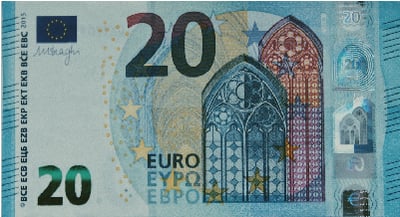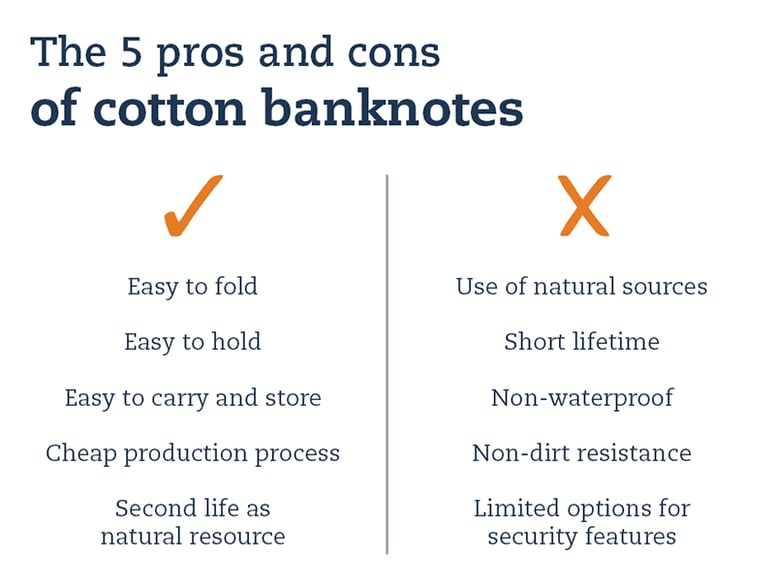Cotton banknotes; What are they made from? How are they made? How long do they last? Are they recyclable? In this blog, we will discuss their pros and cons.
Overview of content
What are cotton banknotes made from?
How are cotton banknotes made?
What are the advantages of cotton banknotes?
What are the disadvantages of cotton banknotes?
What happens to damaged, unfit cotton banknotes?
What are cotton banknotes made from?
Cotton banknotes are made from cotton paper, a mix of cotton (75%) and linen (25%). In Europe, for instance, so-called comber noils are used. These are short cotton fibers that are a waste stream from the textile industry. The exact ratio of cotton, linen and other materials are kept secret and can vary between countries.
The reason to use cotton paper is that it is light, printable and suitable for security features. Furthermore, cotton fibers are strong, yet soft and flexible. This combination makes cotton paper pure and durable.
How are cotton banknotes made?
The Central Banks are responsible for the coordination of the production of new banknotes. First, the cotton is separated from the cotton bales and transferred into paper pulp. This is the foundation for the cotton paper, which is rolled up on big reels. The next step is watermarking the paper. After security control of the watermarks, the rolls are cut in smaller reels. Then, depending on the design of the banknote, the security thred, window, metallic foil or hologram stripes are added. Finally, the paper is cut into sheets.
Now, the paper is ready to be printed. This happens at the Central Banks or designated Printing Works. Printing the paper generally contains four printing stages. After a final check, the paper is cut into the size of banknotes we know.

What are the advantages of cotton banknotes?
- 1. Easy to fold
- Thanks to the soft and flexible structure of cotton fibers, the banknotes are easy to fold without instantly leaving creases along the fold line.
- 2. Easy to hold
- The fiber structure of cotton paper makes the surface of the banknotes rougher and so less slippery. As a result, the banknotes are easy to hold and handle.
- 3. Easy to carry and store
- Cotton banknotes are light, require few space and can be folded. This makes them easier to store than, for example, coins.
- 4. Cheap production process
- The costs of producing cotton banknotes are lower than for other forms of cash.
- 5. Second life as natural resource
- Instead of dumping banknotes shreds and briquettes in landfills or incinerators, we suggest
- recycling them in means of the caloric value of cotton. The cement and ceramic industry, for
- example, needs a lot of fuel to produce cement and ceramic. Used cotton banknotes can be a
- good substitute. Another possible solution is to compost the unfit cotton banknotes.
Also read: Turning cash in to a natural resource; Recycling banknotes
What are the disadvantages of cotton banknotes?
- 1. Use of natural sources
- Although a number of countries use comber noils of the textile industry to make cotton banknotes, cotton is a natural crop. Moreover, WWF states that the production of cotton requires a large amount of water. The largest amount of water of all agricultural commodities.
- 2. Short lifetime
- Cotton banknotes have a relatively short lifetime. The average lifetime is 13 to 18 months, depending on denomination and local circumstances (for example, humanity).
- 3. Non-waterproof
- Just like your cotton shirt, cotton banknotes are not resistant to water.
- 4. Non-dirt resistance
- We just said the fiber structure of cotton paper makes the surface of the banknotes rougher and thus less slippery. Unfortunately, rougher also means that they hold relatively much dirt.
- 5. Limited options for security features
- Due to the two-dimensional structure of cotton banknotes, the options for security features are limited.
Also read: The five pros and cons of polymer banknotes

What happens to damaged, unfit cotton banknotes?
Each banknote returns for a check-up to the Bank or Cash Centre every once in a while. The exact period (weeks, months) differs per country and denomination. When the banknote is ripped or damaged, it is labeled as unfit and will be destroyed. Several decades ago, this was done by means of incineration. Today, Central Banks and Printing works shred their misprinted or unfit banknotes, so they can be further processed or recycled in a safe and more sustainable matter.
Also read: Shredding and granulating; Sustainably destroying unfit banknotes
Discover our currency destruction solutions
Royal Dutch Kusters Engineering is world's leading manufacturer of currency destruction equipment. We design, develop, deliver, install and service reliable and secure destruction solutions for all types of banknotes.
If you want to know more about our banknote destruction solutions, please download our banknote destruction brochure.
Keep informed on the latest insights and subscribe to our blog.
Sources
Banknote World
De Nederlandsche Bank (DNB)
Business Finance Articles
World Wild Life (WWF)

